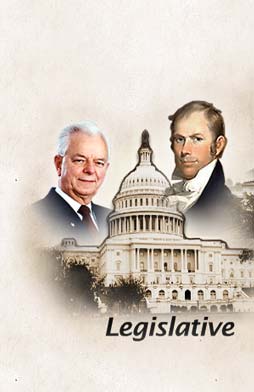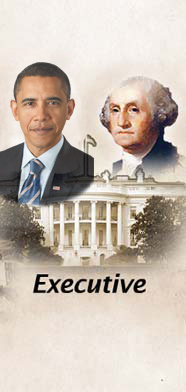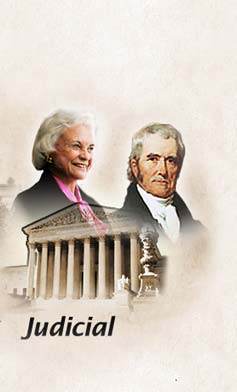United States Department of Defense
U.S. Constitution Course
The Course > Page 7
| < Previous Page | Next Page > |



Imagery:
The Legislative Branch with the Capitol building, Senators Robert C. Byrd and Henry Clay - Robert Byrd: US Senator from West Virginia and author of Constitution Day Legislation. - Henry Clay: US Senator and Speaker of the House of Representative from Kentucky and known as “The Great Compromiser.”
The Executive Branch with the White House, Presidents George Bush and George Washington - George W. Bush: 43rd and current President of the United States and Commander in Chief of the Armed Forces. - George Washington: 1st President of the United States and Commander in Chief of the Continental Army in the American Revolutionary War.
The Judicial Branch with the Supreme Court, Justices Sandra Day O’Connor and John Marshall - Sandra Day O’Connor: Associate Justice of the Supreme Court and the first woman to serve on the Supreme Court. - John Marshall: Chief Justice of the Supreme Court and established the concept of Judicial Review.
Narration:
The Constitution recognizes and specifies three Branches of Government: the Legislative Branch, the Executive Branch and the Judicial Branch.
Want to Know More:
The recognition that government should be constituted of distinct and relatively independent branches was a totally new concept for that era. Suspicious of despotism and strong and centralized monarchial rule – with the King holding the reins of power – the Founding Fathers displayed a preference for Federal decentralization. The Constitution’s scheme of independent branches, with each supplying a machinery of checks and balances over the others, owed much to the writings of French political philosopher Charles Montesquieu (1689-1755).
More Info:
Montesquieu's most radical work divided French society into three classes (or trias politica, a term he coined): the monarchy, the aristocracy, and the commons. Montesquieu saw two types of powers existing: the sovereign and the administrative. The administrative powers were the legislative, the executive, and the judiciary. These powers were to be divided up among the three classes, which he referred to as Estates, so that each would have a power over the other.
His great work, The Spirit of the Laws, 1748, was originally published anonymously and was enormously influential. Montesquieu's thought was a powerful influence on many of the American Founders, most notably James Madison.
Another influence on the Constitution’s creators was the experiences
of the new government of France. In 1789, the new French Government adopted
the Declaration of the Rights of Man and the Citizen. The Declaration,
drafted by the Marquis de Lafayette, puts forward several provisions
similar to the U.S. Constitution and Bill of Rights, which date from
the same year. Like the U.S. Constitution, the Declaration discusses
the need to provide for the common defense and states some broad principles
about taxation, especially equality before taxation (a striking difference
from the pre-revolutionary era, when the Church and the nobility were
exempted from most taxes). Like the U.S. Bill of Rights, it provides
against ex post facto application of criminal law and puts forward such
principles as presumption of innocence, freedom of speech and of the
press, and a slightly weaker guarantee of freedom of religion.
More Info - The Legislative Branch:
Narrator:
The Legislative Branch, or the Congress, creates laws and is composed of two houses: the Senate and the House of Representatives.
On-Screen Text:
The Legislative Branch is composed of a Congress with two independent houses, the Senate and the House of Representatives , which together exercise the power to formulate policies and have them articulated and implemented through laws.
The Senate is composed of 100 Senators, two from each of the 50 states, who represent both the respective state and the people living in their respective state. Senators serve for 6-year terms and one-third of the Senate is up for re-election every two years.
The House of Representatives is composed of 435 Representatives, who
represent individual districts within the 50 states. Districts are apportioned
among the states according to individual states’ populations in
the Federal census. Some states have one district while others have as
many as 53 districts. Representatives serve for 2-year terms and the
entire House of Representatives is up for re-election every two years.
More Info - The Executive Branch:
Narrator:
The Executive Branch is headed by the President, who serves as Commander In Chief of the Armed Forces and executes the laws passed by the Congress.
On-Screen Text:
The Executive Branch is headed by the President, who serves as Commander in Chief of the Armed Forces and executes the laws passed by the Congress.
The President is elected every 4 years and can only serve two terms.
Each President recites the Presidential Oath, in accordance with Article II, Section I of the U.S. Constitution: "I do solemnly swear (or affirm) that I will faithfully execute the office of President of the United States, and will to the best of my ability, preserve, protect and defend the Constitution of the United States."
Your Connection with the Constitution:
Narrator:
The DoD is a Department of the Executive Branch and is accountable to the President. The DoD employee is in a Position of Public Trust and takes the Oath of Allegiance which establishes a direct bond between the Department of Defense employee and the Constitution.
On-Screen Text:
The DoD is a Department of the Executive Branch and is accountable to the President. The DoD has a special relationship to the President as Commander in Chief. The President is designated by the U.S. Constitution as the Commander in Chief of the Army and Navy.
As DoD civilians, we are part of the Total Force who are responsible for implementing the national security strategy. DoD civilian personnel with DoD Active and Reserve military personnel, military retired members, contractor staff and host-nation support personnel are all part of the Total Force.
We are part of the Executive Branch and, as such, we are directly linked to the Constitution. When we take the Oath of Office, we make a personal commitment to uphold the U.S. Constitution.
All Federal employees, from the President to the lowest ranked employee, share commonality in taking an oath of loyalty to the U.S. Constitution.
You may remember when you took the Federal Employee Oath of Office: “I, ……………, do solemnly swear (or affirm) that I will support and defend the Constitution of the United States against all enemies, foreign and domestic; that I will bear true faith and allegiance to the same; that I take this obligation freely, without any mental reservation or purpose of evasion; and that I will well and faithfully discharge the duties of the office on which I am about to enter. So help me God.”
This oath dates to the Civil War. Starting in 1862, Congress required Executive Branch employees to affirm that they did not support the Confederacy and that they would support and defend the Constitution. The wording we use today was adopted by Congress in 1884.
Position of Public Trust
As DoD employees, we must maintain the enduring trust of the American people in the faithful and honorable performance of our duties.
We are held to high standards of conduct that guide our performance
(Executive Order 12371, Principles of Ethical Conduct for Government
Officers and Employees).
More Info - The Judicial Branch:
Narrator:
The Judicial Branch ensures that the Constitution is upheld and is
composed of
the Supreme Court and Circuit and District Federal Courts.
On-Screen Text:
The Judicial Branch ensures that the U.S. Constitution is upheld and
is composed of:
The Supreme Court, which makes final decisions on interpretations
of the U.S. Constitution and Circuit and District Federal Courts.
The Supreme Court makes final decisions on the interpretations of the U.S. Constitution and the decisions of state courts.
The doctrine of judicial review is central to the U.S. constitutional system. It empowers courts to examine legislation and executive decisions to assess their compliance to the Constitution. The doctrine emerged from the decision written by Chief Justice Marshall, Marbury vs. Madison.
Every Federal judge must take the statutory oath of office before exercising
the judicial authority of the United States. The oath is actually a combination
of the judicial oath of office and the general oath administered to all
federal employees as set forth in 28 U.S.C. § 453 and 5 U.S.C. § 3331.
The oath is: “I, ......................., do solemnly swear (or
affirm) that I will administer justice without respect to persons, and
do equal right to the poor and to the rich, and that I will faithfully
and impartially discharge and perform all the duties incumbent upon me
as .......................... under the Constitution and laws of the
United States; and that I will support and defend the Constitution of
the United States against all enemies, foreign and domestic; that I will
bear true faith and allegiance to the same; that I take this obligation
freely, without any mental reservation or purpose of evasion; and that
I will well and faithfully discharge the duties of the office on which
I am about to enter. So help me God.”